| dc.contributor.author | Sun, Ruoshi | |
| dc.contributor.author | Chan, Maria K. | |
| dc.contributor.author | Ceder, Gerbrand | |
| dc.date.accessioned | 2011-09-16T17:41:28Z | |
| dc.date.available | 2011-09-16T17:41:28Z | |
| dc.date.issued | 2011-06 | |
| dc.date.submitted | 2011-03 | |
| dc.identifier.issn | 1098-0121 | |
| dc.identifier.issn | 1550-235X | |
| dc.identifier.uri | http://hdl.handle.net/1721.1/65869 | |
| dc.description.abstract | Despite the many advantages (e.g., suitable band gap, exceptional optical absorptivity, earth abundance) of pyrite as a photovoltaic material, its low open-circuit voltage (OCV) has remained the biggest challenge preventing its use in practical devices. Two of the most widely accepted reasons for the cause of the low OCV are (i) Fermi level pinning due to intrinsic surface states that appear as gap states, and (ii) the presence of the metastable polymorph, marcasite. In this paper, we investigate these claims, via density-functional theory, by examining the electronic structure, bulk, surface, and interfacial energies of pyrite and marcasite. Regardless of whether the Hubbard U correction is applied, the intrinsic {100} surface states are found to be of dz2 character, as expected from ligand field theory. However, they are not gap states but rather located at the conduction-band edge. Thus, ligand field splitting at the symmetry-broken surface cannot be the sole cause of the low OCV. We also investigate epitaxial growth of marcasite on pyrite. Based on the surface, interfacial, and strain energies of pyrite and marcasite, we find from our model that only one layer of epitaxial growth of marcasite is thermodynamically favorable. Within all methods used (LDA, GGA-PBE, GGA-PBE+U, GGA-AM05, GGA-AM05+U, HSE06, and delta-sol), the marcasite band gap is not less than the pyrite band gap, and is even larger than the experimental marcasite gap. Moreover, gap states are not observed at the pyrite-marcasite interface. We conclude that intrinsic surface states or the presence of marcasite are unlikely to undermine the photovoltaic performance of pyrite. | en_US |
| dc.description.sponsorship | United States. Dept. of Energy (contract DE-FG02-96ER45571) | en_US |
| dc.description.sponsorship | National Science Foundation (U.S.) (TeraGrid resources provided by Texas Advanced ComputingCenter (TACC) under grant TG-DMR970008S.) | en_US |
| dc.language.iso | en_US | |
| dc.publisher | American Physical Society | en_US |
| dc.relation.isversionof | http://dx.doi.org/10.1103/PhysRevB.83.235311 | en_US |
| dc.rights | Article is made available in accordance with the publisher's policy and may be subject to US copyright law. Please refer to the publisher's site for terms of use. | en_US |
| dc.source | APS | en_US |
| dc.title | First-principles electronic structure and relative stability of pyrite and marcasite: Implications for photovoltaic performance | en_US |
| dc.type | Article | en_US |
| dc.identifier.citation | Sun, Ruoshi, M. Chan, and G. Ceder. “First-principles Electronic Structure and Relative Stability of Pyrite and Marcasite: Implications for Photovoltaic Performance.” Physical Review B 83.23 (2011) : 235311 ©2011 American Physical Society | en_US |
| dc.contributor.department | Massachusetts Institute of Technology. Department of Materials Science and Engineering | en_US |
| dc.contributor.approver | Ceder, Gerbrand | |
| dc.contributor.mitauthor | Sun, Ruoshi | |
| dc.contributor.mitauthor | Chan, Maria K. | |
| dc.contributor.mitauthor | Ceder, Gerbrand | |
| dc.relation.journal | Physical Review B | en_US |
| dc.eprint.version | Final published version | en_US |
| dc.type.uri | http://purl.org/eprint/type/JournalArticle | en_US |
| eprint.status | http://purl.org/eprint/status/PeerReviewed | en_US |
| dspace.orderedauthors | Sun, Ruoshi; Chan, M.; Ceder, G. | en |
| dc.identifier.orcid | https://orcid.org/0000-0002-6833-3480 | |
| dspace.mitauthor.error | true | |
| mit.license | PUBLISHER_POLICY | en_US |
| mit.metadata.status | Complete | |
